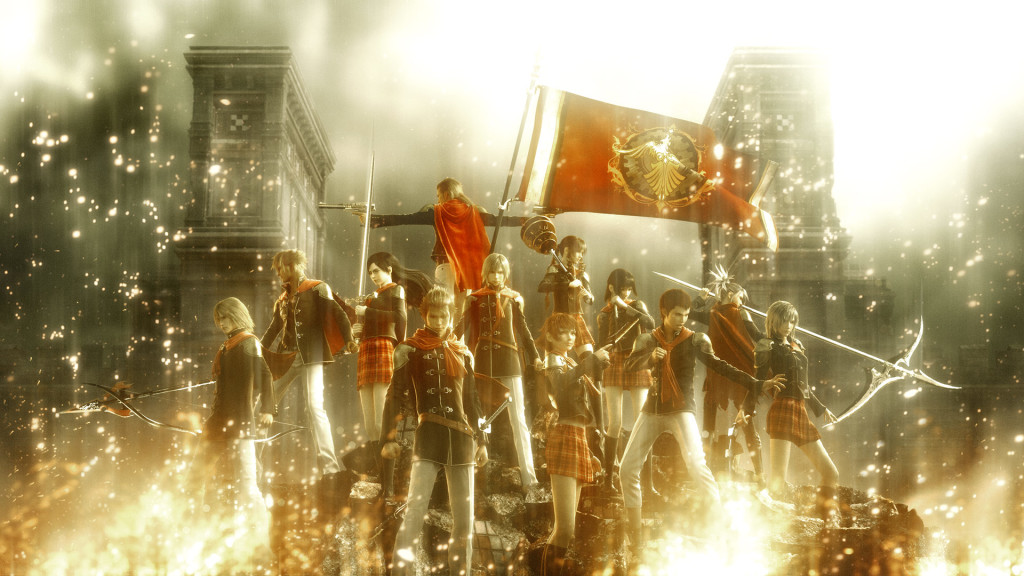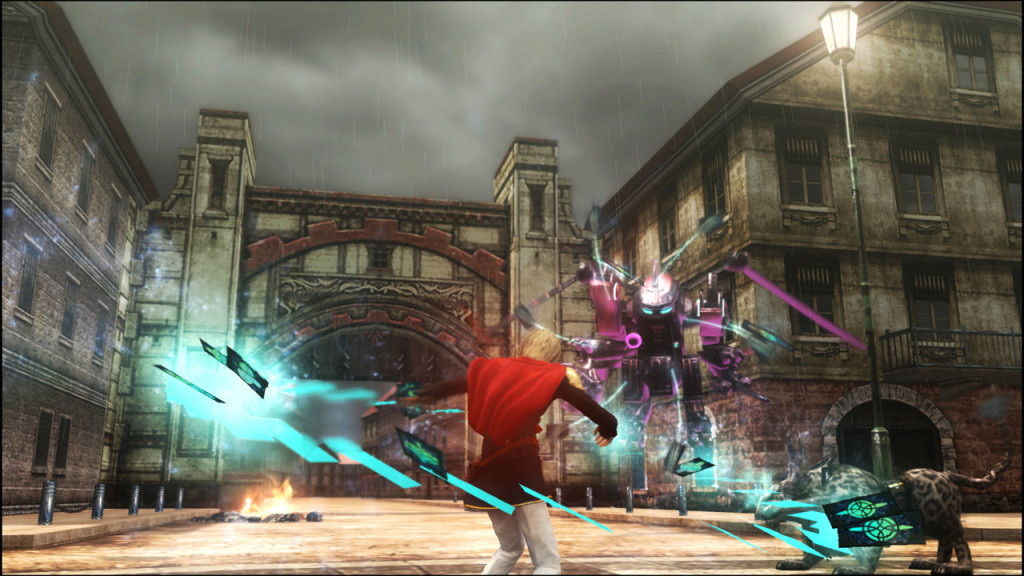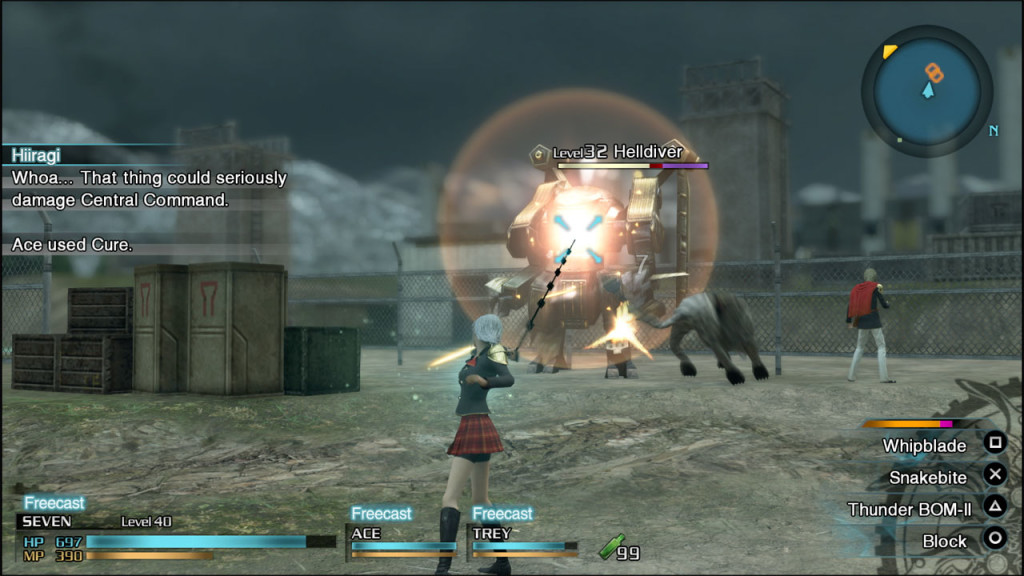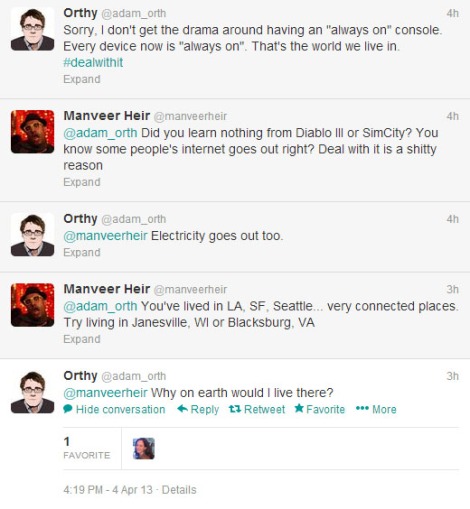 Since the initial inception of Final Fantasy on the NES in 1987, Square-Enix (previously Squaresoft) has developed a pretty consistent formula in the release of all their titles. And for the most part, it’s worked – now I’ve got some perspective on this, as I’ve played every (non-MMO) edition since I was a wee brown lad. Go ahead, I’ll pause a moment so you can marvel at my advanced age, kids.
Since the initial inception of Final Fantasy on the NES in 1987, Square-Enix (previously Squaresoft) has developed a pretty consistent formula in the release of all their titles. And for the most part, it’s worked – now I’ve got some perspective on this, as I’ve played every (non-MMO) edition since I was a wee brown lad. Go ahead, I’ll pause a moment so you can marvel at my advanced age, kids.
Granted the formula will always have some tweaks to the core to freshen the mechanic from time to time – summons were added, job roles and classes in V, items like materia in VII, that annoying draw system from VIII, then grids and maps for skills and upgrades in X and beyond. And this all revolved around a two pronged attack of a massive world to explore along with a tried and true turn-based combat system. And the gaming and RPG gods did smile, as they saw that it was good.
Then Final Fantasy XIII happened.
Much the like the compendium of Final Fantasy VII, which included a multimedia immersion into that universe, XIII was supposed to have gone a similar (read: NOT identical) route. These games were all to share a mythology in a series called Fabula Nova Crystallis, and in addition to the core XIII titles, there were two additional games that were going to be thrown into the mix – Final Fantasy Agito XIII an Final Fantasy Versus XIII. Agito was released for mobile platforms but we never really saw much of it in the US, and Versus basically vanished into vaporware. It was a real shame at the time because they looked like a different take on the traditional title. Lightning’s adventures in XIII as the core were pretty polarizing though, leading most people into a love it or hate it scenario about S-E’s most recent entry to the franchise. True, XIII was a lot more interactive story than game, and the exploration piece of a traditional Final Fantasy game didn’t appear with as much gusto, but I for one still enjoyed it.
Well, after playing halfway through then giving up then starting over and having far more appreciation for it as well as Lightning herself.
To distance them from the XIII universe, these two games were split off into separate entities. What we knew as Versus XIII became Final Fantasy XV (the demo Episode Duscae of which was reviewed by Colby here), and from the ashes of Agito XIII rose Final Fantasy Type-0. And you know what? I can only describe Final Fantasy Type-0 as the greatest documentary I’ve ever played.
 In most RPG’s you’ll find that there’s three types of movies. One is full motion video. The second is dialogue and animation using the game engine. This one has a third – History Channel style explanations of battalion movements and war maps with dates and voiceovers so the player can understand the meta of the war at hand instead of just what they’re playing through. It gives it a very strange but satisfying documentary feel, and these types of clips to me work very well in tying everything together and keeping me immersed in the lore and world events. This game becomes, in fact, an interactive retelling of the accounts of the war between the Crystal States of Orience, and it pulls it off very well.
In most RPG’s you’ll find that there’s three types of movies. One is full motion video. The second is dialogue and animation using the game engine. This one has a third – History Channel style explanations of battalion movements and war maps with dates and voiceovers so the player can understand the meta of the war at hand instead of just what they’re playing through. It gives it a very strange but satisfying documentary feel, and these types of clips to me work very well in tying everything together and keeping me immersed in the lore and world events. This game becomes, in fact, an interactive retelling of the accounts of the war between the Crystal States of Orience, and it pulls it off very well.
That aside, the gameplay is a stark departure from what we know from most of the Final Fantasy games. It’s full-on action where skills are thrown on the fly – there’s no waiting for a turn, there’s no running to escape a battle encounter or random encounters like in previous games of the series (think kind of like Crisis Core). The four buttons at your disposal on the controller map to 4 commands – generally one standard attack, a special, a magic, and a defensive skill. These can all be changed out with different skills and spells as your characters level up and gain ability points. Much like X and titles beyond it there are three party members that can be deployed at once – one that you directly control while the other two work on AI. You can freely switch which character you control if ever you need a different skillset for a certain enemy or you’re just running low on health. It’s a fun system that allows on-the-fly style change in how you attack the game.
 To add more customization, there are twelve characters (there’s two add-ons too but they don’t fit the theme) from which to pick your team, each one with a different weapon and style that fits different scenarios. Each character is named after a playing card rank (Deuce through Ace with no “Ten”) and have their own equipment and spells, all of which you have control over. Ace himself uses playing cards as a weapon at range, while the other two characters you begin with, Nine and Queen, use a spear and a sword for more melee-oriented combat. In addition to their own offense each character has their own defensive style that can help you out in a jam. Ace’s “Wall” for example helps when taking ranged attack without cover. Fast switching between each character to utilize their skills becomes as much of a skill to learn itself, but when you do, boy does this game get fun in a hurry.
To add more customization, there are twelve characters (there’s two add-ons too but they don’t fit the theme) from which to pick your team, each one with a different weapon and style that fits different scenarios. Each character is named after a playing card rank (Deuce through Ace with no “Ten”) and have their own equipment and spells, all of which you have control over. Ace himself uses playing cards as a weapon at range, while the other two characters you begin with, Nine and Queen, use a spear and a sword for more melee-oriented combat. In addition to their own offense each character has their own defensive style that can help you out in a jam. Ace’s “Wall” for example helps when taking ranged attack without cover. Fast switching between each character to utilize their skills becomes as much of a skill to learn itself, but when you do, boy does this game get fun in a hurry.
The story is a fairly simple tale of power and struggle between kingdoms in a different age – in this case starting in year 842 in the world of Orience. The Militesi Empire invades the dominion of Rubrum (our characters) unprovoked, using technology to snuff out the magic Rubrum relies on for its military using their White Tiger Crystal, destroying much of the countryside in its assault. Rubrum’s crystal, the Vermillion Bird, grants them the power of magic and Eidolons to defend themselves. Militesi and Rubrum are two of the four Crystal States, with Concordia Kingdom and the Lorican Alliance rounding out the other two. And thus war begins, with you controlling the Rubrum Akademia’s legendary Zero class, hoping that one of them will become the fabled Agito to bring balance to the end time, or tempus finis. So yes, there are four crystals in the game as is always somewhat expected. Where this ties in with Fabula Nova Crystallis is that the crystals are sentient, and create l’Cie to do their bidding, serving the same role the Fal’cie did in XIII.
Square-Enix also went through some effort to add a lot of familiar elements to the game, softening a bit of the shock of being this different to previous games in the franchise – not only within the Final Fantasy universes, but more specifically from within Fabula Nova Crystallis. Summons are called Eidolons and there are branded magic users called l’Cie like in XIII. There’s Magitek armor like in VI. There’s four crystals (for the purists fine, yes, back then they were “orbs”) like there have been since day 1. And possibly the greatest homage to a previous game in the series, twelve people genetically enhanced to serve a greater purpose, all referring to the scientist that created them as “Mother.” Final Fantasy VII? Feel a little bit like Sephiroth clones and Jenova anyone? It helps give you a familiarity with the game even though it’s a brand new environment.
In all, good fun, and a different flavor of the Final Fantasy universe that’s a a breath of fresh air.
Tushar Nene
Staff Writer
@tusharnene
REVIEW | Salt and Sanctuary
PAX South 2019: Splitgate Arena Warfare, World of Horror, JackQuest, and Disjunction
PAX South 2019: Jump Force, Skellboy, A Fold Apart
REVIEW | Spider-Man PS4
Review | Re-Exploring No Man’s Sky Next
REVIEW | Downward Spiral: Horus Station
 Remember when I told you kids about the rumor that the next iteration of the Xbox console would require an always-on connection? Even after those rumors have spread like wildfire, drawing a collective “WTF guys?” from the gaming community, Microsoft is still unwilling to confirm or deny an always-on requirement to operate their next-gen Xbox, codenamed “Durango.” In my opinion it is that same refusal that is keeping the rumor alive and drawing gamers’ ire. It’s really simple fix – all we want is a straight answer. Yes or no, that’s all it would take.
Remember when I told you kids about the rumor that the next iteration of the Xbox console would require an always-on connection? Even after those rumors have spread like wildfire, drawing a collective “WTF guys?” from the gaming community, Microsoft is still unwilling to confirm or deny an always-on requirement to operate their next-gen Xbox, codenamed “Durango.” In my opinion it is that same refusal that is keeping the rumor alive and drawing gamers’ ire. It’s really simple fix – all we want is a straight answer. Yes or no, that’s all it would take.
But instead of real answers from Microsoft to their customer base (that pay hundreds per console and upwards of $50 per title) through a statement or press release, what we got instead was arrogance, ignorance, and insult from Microsoft Studios’ Creative Director Adam Orth (@adam_orth). Over Twitter. After going on about how he doesn’t see the big deal about always-on devices and software, he added one choice hashtag to the proceedings:
#dealwithit.
That was his answer. Classy, man.
 After BioWare’s Manveer Heir (@manveerheir) cited the always-on issues that arose with Diablo III and SimCity, Orth quipped that “Electricity goes out too” and sarcastically followed up with “I will not buy a vacuum cleaner” and other assy things of the like. His twitter feed has since been protected (uh ohhhhh I think the boss may be angryyyy), but of course a number of screencaps were taken around the web to let everyone know how it went down. For someone who really loves always-on that much, I figured he would have known that stuff you put out on the internet can last forever. Thanks to HuffPost Tech UK by the way for this lovely capture.
After BioWare’s Manveer Heir (@manveerheir) cited the always-on issues that arose with Diablo III and SimCity, Orth quipped that “Electricity goes out too” and sarcastically followed up with “I will not buy a vacuum cleaner” and other assy things of the like. His twitter feed has since been protected (uh ohhhhh I think the boss may be angryyyy), but of course a number of screencaps were taken around the web to let everyone know how it went down. For someone who really loves always-on that much, I figured he would have known that stuff you put out on the internet can last forever. Thanks to HuffPost Tech UK by the way for this lovely capture.
As far as the validity of the always-on rumors, it was Kotaku who finally furnished an answer for us. Their sources say that the answer is not only “yes,” but that it will only take 3 minutes of being offline to not be able to play anymore. So why not just tell us that in the first place?
I’m surprised that Orth, someone who’s been in the industry for a while (he’s spent time with SCEA and LucasArts), could make such a shortsighted comment after the very public fiascoes concerning Diablo III last year and SimCity just last month. The comment shows an alarming amount of industry ignorance for someone in such an important position, and says to me that Microsoft is catering only to users that have stable always-on broadband connections, telling those who don’t to deal with it. There are a number of areas in the United States that either don’t or have spotty service. You guys ever use Skype internationally or to someone in the remote USA? play World of Warcraft or any other MMO? Then I’m sure you noticed that some players would lose connection and drop wayyyy more frequently than others. If that’s the case, then your wiped raid is evidence of this fact. For those users, a 3 minute timer would render this console unplayable. And that’s just in the United States. What about American military personnel that game during deployments to remote areas? In remote areas they’re running on connections reliant on satellites in geosynchronous orbit, where some areas can only be reached by certain satellites, possibly giving a skewed signal on a flatter-than-optimal angle. So there are definitely potential issues with that setup.
And what about international users? A lot of those users may find similar problems.
Working in IT I get that Microsoft’s plan forward on their enterprise side is pushing everyone cloud-ward with SkyDrive and their 2013 line of Office. Given that they’ve been talking for a while about a Microsoft “ecosystem” that would combine Microsoft OS’es with Xbox, their moves including this one don’t seem so shocking. But aside from that, they need to understand that this business model going forward is not only going to hurt their users, but their own brand. Sony has made no such assertion that the PlayStation 4 would have an always-on component, so this helps them too, potentially giving them the opportunity to take some ground and have a chuckle at the same time. But we still don’t have a straight answer. So it looks like we’re going to have wait until E3 to see any sort of confirmation from Microsoft. Meaning they have until June to get it together with a unified front and message to users, without rogue employees going berserk on social media.
Let me be clear on my stance on this sort of business practice in case you don’t know already. I am against always-on. In my opinion it’s a form of DRM that is sharply anti-consumer, especially now that we have laptops that have the graphics card juice to play modern games. Always-on means I can’t play Diablo III on a flight, or SimCity on a long train ride. And dictating when and where we can play our games just isn’t right. We’ve been burned with it more than once. But the problem is partially us. Always-on seems to be the way the industry is going, and we tacitly support it by still buying the games knowing the potential issues going in. At that point, they already have our money, so why should they care? They’ll move on, and quickly. And we’ll be left wondering what to do when they finally shut down those connection servers.
Tushar Nene
Staff Writer
@tusharnene











